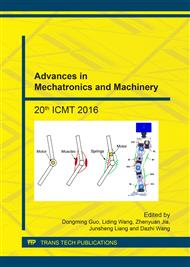[1]
W. Y. Liu, J. G. Han, J. L. Jiang, A novel ball bearing fault diagnosis approach based on auto term window method, Measurement. (2013) 4032-4037.
DOI: 10.1016/j.measurement.2013.07.039
Google Scholar
[2]
Z. Chen, N. Gao, W. Sun, A Signal Based Triangular Structuring Element for Mathematical Morphological Analysis and Its Application in Rolling Element Bearing Fault Diagnosis, Shock & Vibration. (2014)1-16.
DOI: 10.1155/2014/590875
Google Scholar
[3]
G. Feng, D. Zhen, X. Tian, A Novel Method to Improve the Resolution of Envelope Spectrum for Bearing Fault Diagnosis Based on a Wireless Sensor Node, Mechanisms & Machine Science. (2014)765-775.
DOI: 10.1007/978-3-319-09918-7_68
Google Scholar
[4]
J. S. Smith, The local mean decomposition and its application to EEG perception data, Journal of the Royal Society Interface. (2005)443-454.
DOI: 10.1098/rsif.2005.0058
Google Scholar
[5]
H. Saruhan, S. Sandemir, A. Çiçek, Vibration analysis of rolling element bearings defects, Journal of Applied Research and Technology. (2014)384-395.
DOI: 10.1016/s1665-6423(14)71620-7
Google Scholar
[6]
N. Sawalhi, R. B. Rall, D. Forrester, Separation and enhancement of gear and bearing signals for the diagnosis of wind turbine transmission systems, Wind Energy. (2014)729-743.
DOI: 10.1002/we.1671
Google Scholar
[7]
V. Venkat, K. Chan, Aiche Journal, A neural network methodology for process fault diagnosis, Aiche Journal. (1989)1993-(2002).
DOI: 10.1002/aic.690351210
Google Scholar
[8]
J. Ma, J. Wu, X. Yuan, The fault diagnosis of the rolling bearing based on the LMD and time-frequency analysis, International Journal of Control and Automation. (2013)357-374.
Google Scholar
[9]
X. H. Liu, X. L. Hu, L. X. Du, Rolling Parameter Calculation Model and Its Application, Chemical Industry Press, China, (2009).
Google Scholar
[10]
X. Y. Liu, H. Liu, Artificial Neural Network and Particle Swarm Optimization, Beijing University of Posts and Telecommunications Press, China, (2008).
Google Scholar
[11]
Fu, H. X. and Zhao, H., MATLAB Neural Network Application Design, China Machine Press, China, (2010).
Google Scholar
[12]
J. L. Tao, N. Wang, Splicing system based Genetic Algorithms for developing RBF networks models, Chinese Journal of Chemical Engineering. 15(2007)240-246.
DOI: 10.1016/s1004-9541(07)60065-2
Google Scholar
[13]
H. T. He, H. M. Liu, The research on integrated neural networks in rolling load prediction system for temper mill, Fourth international conference on machine learning and cybernetics. (2005)18-21.
DOI: 10.1109/icmlc.2005.1527653
Google Scholar
[14]
X. Li, A. Yu, H. Sun, F. Jia, M. Pan, Aquaculture monitoring system design based on BP neural network algorithm. International Journal of Advancements in Computing Technology. 5(2013)779-788.
DOI: 10.4156/ijact.vol5.issue3.90
Google Scholar
[15]
Poultangaria, I., Shahnazib, R., Sheikhan, M., RBF neural network based PI pitch controller for a class of 5-MW wind turbines using particle swarm optimization algorithm, ISA Transactions. 51(2012)641-648.
DOI: 10.1016/j.isatra.2012.06.001
Google Scholar
[16]
J. P. Jiang, Prediction of ultimate bearing capacity of prestressed pipe pile based on BP neural network, Applied Mechanics & Materials. (2012)228-231.
DOI: 10.4028/www.scientific.net/amm.101-102.228
Google Scholar
[17]
W. Kang, T. Chu, H. X. Zhao, The design of constant tension system based on BP neural network PID control, Scientific Journal of Control Engineering. 4(2014)58-63.
Google Scholar
[18]
W. J. Li, J. Zhang, K. L. Tian, H. Y. Sun, The design of the BP neural network character recognition in Matlab environment, Advanced Materials Research. (2014)1117-1120.
DOI: 10.4028/www.scientific.net/amr.1006-1007.1117
Google Scholar


